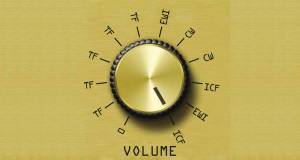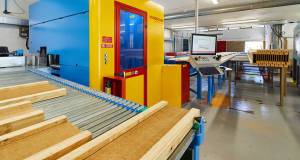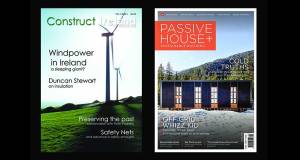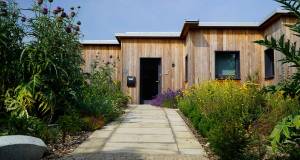
- Blogs
- Posted
What can Ireland learn from German construction?
Following on from my post on a two-week trip to Germany to study low energy building under the Phase Programme, I sent some questions to Torsten Windmueller, a timber engineer at Kompetenz Zentrum Holzbau & Ausbau, a centre of excellence for timber frame construction, to gauge his thoughts on the differences between building standards in Germany and Ireland.
For those who haven't read my previous post and are unfamiliar with the course, what exactly is the Phase Programme and what are candidates taught during the two weeks at the KomZet in Biberach?
Phase is a program within the European Leonardo-da-Vinci mobility program. The aim of this program is to increase European mobility and to send people in the labour market to another European country and offer them an insight into their professional field in that country. CIT in Cork (from next year on the ITB in Dublin) tries to find carpenters, engineers and architects who want to learn how passive houses are designed and built in Germany. The participants learn about topics like air-tightness and ventilation systems, building physics, passive house design and construction details. Additionally we provide one day of practical training for our students to experience problems in reality. We also visit building sites, prefabricated passive house manufacturers and suppliers of building products. We try to teach the basics and show examples of how we are building in Germany. Having this knowledge participants can find their own solutions to their problems back in Ireland and can develop a low energy house using typical Irish building products and constructions.
I understand that you have quite a lot of experience in the timber industry. What is your background?
I am a cabinet maker by trade and a timber engineer. I have worked for the University of Stuttgart for nine years where I was responsible for the controlling of prefabricated house manufacturers in north Europe and issuing a certificate for glue laminated beam manufacturers in Europe. For the past five years I have been working for the "Berufsförderungswerk" (Vocational Education Centre). My work still involves the control of prefabricated house manufacturers but mainly I am responsible for finding partners in Europe for mobility projects, setting up teaching content and finding lecturers. I enjoy having groups with us from different countries and experiencing cultural differences.
Have many Irish building professionals have travelled to the KomZet? What backgrounds do the people who have completed the Phase course have?
The Phase program has been running for two years and we have had 101 participants so far in. In all programs we are running for people in the labour market we have had 379 participants from Ireland so far. In the Phase project we have had approximately 50% craftsmen and 50% engineers and architects.
What has been your overall experience of the Irish visitors to the KomZet? How would you rate their knowledge of the industry and their attitudes toward sustainable construction?
Most of our Irish visitors were eager to learn something new or to learn about new solutions for their construction problems. Therefore their attitude towards sustainable construction and low energy construction was higher than the average Irish craftsmen or engineer. To rate their knowledge is rather difficult because they are coming to learn something, we do not test their existing knowledge.
I understand that you have visited Ireland in the past. Are you familiar with Irish building regulations and practices? How far are we behind Germany?
Most of the lecturers of the Phase program visited Ireland in 2010 to learn where our participants are coming from and what type of construction materials are used. The Irish building construction details differ due to culture and climate differences from those in Germany. Nevertheless I was amazed how little people in general cared about their houses, and why small defects like a downpipe leak were not fixed fast and for a small amount of money, until the problem grew bigger and a large surface of the outer wall was soaking wet and covered with algae. To use a double brick wall with a cavity seemed to be standard in Ireland. With new regulations regarding the energy consumption of buildings I guess we will see more solid walls in order to save materials and thickness of walls. Construction details are always developed according to the weather conditions and the building materials available. People were used to this construction over decades and it is difficult to change their habits even if we have a wider range of materials available nowadays. That counts for Germany as well as for Ireland. Nevertheless looking at your building regulations and minimum requirements I would say Ireland is about 10 years behind. In my opinion it should be fairly easy for Ireland to catch up on Germany though, as you don't face as severe weather conditions as we do.
A sample wall and facade cross-section shown to our group at the Gapp Holzbau showroom, the visit having been organised by Torsten.
Based on your own experience of Ireland, through your visits and interaction with the Irish students at the KomZet, what do you believe the future holds for the Irish construction industry and our practices?
In my opinion the future holds pretty much the same for all of us. We have to reduce the use of energy by building low energy or even energy plus housing. We have to refurbish existing houses in order to reduce their energy consumption. This means we have to leave the old paths and have to find new constructions and get used to new details. Being behind holds a benefit for the Irish industry: they do not have to invent the wheel again and can avoid the mistakes made in Sweden, Austria or Germany.
What can we do to make right our past mistakes, in terms of retrofitting our current building stock? Do you believe the passive house standard is right for Ireland?
As mentioned before, I personally believe that the energy consumption of our buildings has to drop significantly in the near future if we still want to be able to pay the energy costs. Therefore it does not matter if you call it "passivhaus", "minergy" or "plus energy house". All over Europe we have a lot of buildings from the 50s, 60s and 70s with single glazed windows and no, or hardly any, insulation. All of these buildings must be retrofitted in the most ecological way feasible.
What advice would you give to people looking to develop a career in the area of high performance and sustainable building in Ireland?
Sooner or later we all will work in this field. To have a head start, book courses with people that have experience in that field and try to get to countries where they have a long experience with sustainable buildings.
To find out more about the course, visit http://www.cit.ie/passivehousing.
[It should be noted also, that Torsten visited Ireland in 2010, and again quite recently (after I had posed these questions to him) - eds]








